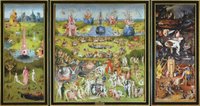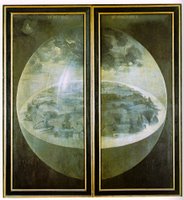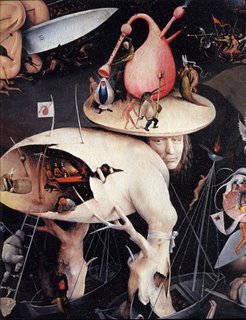Hieronymus Bosch

Hieronymus Bosch, or Jheronimus Bosch, was born sometime near 1450 in Germany. His hometown isn't known for painters, but for many excellent gold and silversmiths, authors, embroiderers, illustrators, carvers, printers, booksellers, and sculptors. Bosch was integral in helping design many aspects of Saint John's Cathedral including stained glass, liturgical garments and copper work. He was a highly commisioned artist, and became very reputable for both his religious art, and more profane themes.
His paintings are filled with color and incredible detail, and are filled with strangely animated objects, bizarre creatures, and monstrous, amusing, or diabolical figures. 'Characters' in his art are believed to have been suggested by folk legends, allegorical poems, moralizing religious literature, or aspects of late Gothic art.
Bosch painted many 'triptychs', a style of painting that has three side-by-side parts, or panels. This style was a commmon form for altar pieces. Bosch painted many triptychs because much of his work was commissioned by churches.

The Garden of Earthly Delights by Hieronymus Bosch 1504. Triptych, plus shutters. Central panel 220 x 195cm. Wings , 220 x 97cm. Oil on Panel.
Subject: religious, death and morbidity, surrealism
Subject Matter: The creation of the world, earthly paradise, earthly delights, punishment of sinners in hell.
Form: Oil on Panel. 220 x 195 for center panel, 220 x 97 for wings. Incredible detail mixed with a very full painting. Many different areas of interest and subjects.
Content: "The Garden of Earthly Delights" is a famous triptych by Bosch. It was painted in three sections, and folds together like a large pamphlet. On the outside of each of the side panels, (what would be the front of the painting when 'closed' ) is a depiction of the creation of the world from the book of Genesis.


The left panel shows earthly paradise. In the foreground God is blessing Adam and Eve. The center of the painting contains red globe with an owl in it, the symbol of wisdom. It may have been intended as a point of concentration for meditating.
 The tall structure rising from the Owl is the Fountain of Life, and behind Eve, on the far left, we can see the Tree of Knowledge. In the lower right corner is a pit, symbolizing evil.
The tall structure rising from the Owl is the Fountain of Life, and behind Eve, on the far left, we can see the Tree of Knowledge. In the lower right corner is a pit, symbolizing evil. Tree of Knowledge, Adam, God, Eve
Tree of Knowledge, Adam, God, EveThe Center Panel depicts life on earth after sin. Nude figures drink from the pool of lust, and countless nude couples engage in sensual acts, seemingly care-free in their environment of lust, desire, and filth. The amount of activity in this one scene is almost indescribable.

One peculiar 'scene' occurs in the lower right of the painting, a youthful couple is shown engaging in an odd sexual act. The boy is putting flowers in his lady friend's backside.....
The right wing is Bosch's macabre depiction of Hell. A burning city sets the background. Bosch used musical intsruments to symbolize lust, and therefore these objects become objects of torture in his art. On the left we see a nude figure tied to the neck of a lute, while another has been entangled in the strings of a harp and a third has been stuffed down the neck of a great horn. Everyday objects and creatures are used to represent torture. A close look will find a rabbit carrying a bleeding body, a pig wearing nun's clothing attacks a man, a pair of ears grinds a knife over a body.
In the foreground of the painting, the damned receive punishment in the form of their sins. A glutton is forced to vomit and a proud woman admires herself in the backside of a demon

The center of Hell shows the 'Man-Tree', a character who appeared in a sketch by Bosch much earlier(1400's). The face that looks back on Hell is actually the artist himself. The figure has an eggshaped body which rests on a pair of rotting tree trunks sitting in boats on a frozen sea. The broken egg-shell symbolizes moral fall, and the branches piercing his body symbolize spiritual death. On his head devils and victims dance around a bagpipe, symbolic of lust, and various other sins. A tavern is set up inside the 'Man-Tree', and shows men gambling around a small table, while a witch pours wine from a keg on the left. A shrouded figure climbs a ladder up to the tavern, showing that he is so degenerate, that he is going up, just to reach a 'less-filthy' level.
This triptych is arranged around a succession of themes across the panels, and transition from good to bad. This piece gets its name from the center panel, as the figures are engaging in earthly delights and not heavenly ones.

